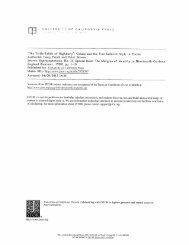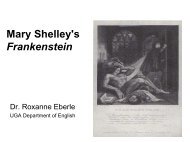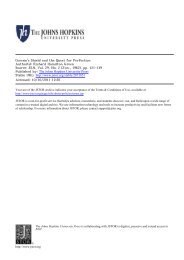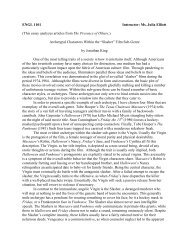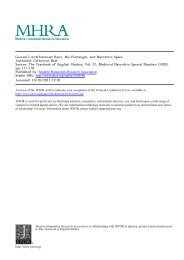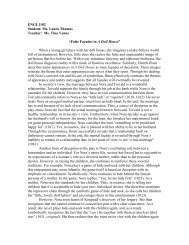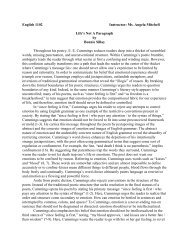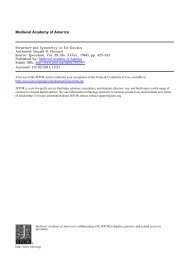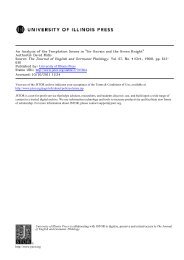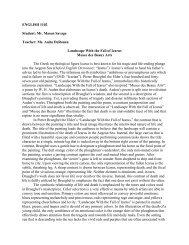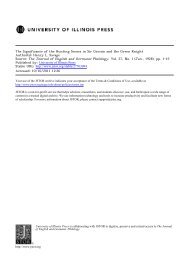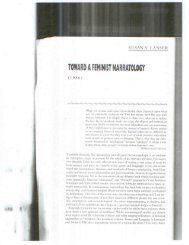The Not So Wonderful World of Disney
The Not So Wonderful World of Disney
The Not So Wonderful World of Disney
You also want an ePaper? Increase the reach of your titles
YUMPU automatically turns print PDFs into web optimized ePapers that Google loves.
ENGLISH 1101<br />
Student: Caroline Smith<br />
Teacher: Ms. Lisa Bolding<br />
<strong>The</strong> <strong>Not</strong> <strong>So</strong> <strong>Wonderful</strong> <strong>World</strong> <strong>of</strong> <strong>Disney</strong><br />
<strong>The</strong> “<strong>Wonderful</strong> <strong>World</strong> <strong>of</strong> <strong>Disney</strong>” has been a part <strong>of</strong> America for as long as I can<br />
remember. With its movies, television shows, songs, theme parks, toys, and fictional characters,<br />
<strong>Disney</strong> is the epitome <strong>of</strong> children’s entertainment. <strong>Disney</strong> serves as one <strong>of</strong> the largest sources <strong>of</strong><br />
entertainment to Americans, which is why it reigns as a commercial success and influence in our<br />
country. According to Henry Giroux, a popular critic <strong>of</strong> the Walt <strong>Disney</strong> Company, <strong>Disney</strong>’s<br />
immense success also represents “the power <strong>of</strong> the culture industries to mediate and influence<br />
almost every aspect <strong>of</strong> our lives” (19). However, does <strong>Disney</strong> stand for pure and innocent<br />
entertainment, or does it carry alternative motives that seem to be well-hidden from the public<br />
eye? Many critics argue that <strong>Disney</strong> productions have the ability to affect American children and<br />
families through their insensitive portrayal <strong>of</strong> certain aspects <strong>of</strong> society and culture.<br />
Critics mark the idea <strong>of</strong> negative social influences as one <strong>of</strong> <strong>Disney</strong>’s most ubiquitous<br />
problems. In a study done on the role <strong>of</strong> the Walt <strong>Disney</strong> Company, Vincent Faherty explains<br />
that <strong>Disney</strong> displays certain aspects <strong>of</strong> “social vulnerability which need to be raised to a level <strong>of</strong><br />
public consciousness, given they do affect so many children and families “(17). For example,<br />
<strong>Disney</strong> emphasizes social vulnerability through the overwhelming male dominance displayed in<br />
their animated films. Faherty argues that even though there have been recent movies such as<br />
Mulan and Pocahontas, which portray strong female roles, “the quantitative disproportion <strong>of</strong><br />
male characters in <strong>Disney</strong> animated films needs to be addressed if we expect children to be able<br />
to relate to appropriate role models” (19). Lack <strong>of</strong> females in <strong>Disney</strong> animated films may give<br />
children an altered view <strong>of</strong> modern society, where men serve as the most influential participants.<br />
Males are usually the heroes, the villains, and the parent figures in <strong>Disney</strong> movies. If men are<br />
always the heroes, then women are always the ones who have to be rescued. Females in <strong>Disney</strong><br />
films lack the ability to save their own lives. <strong>The</strong> negative influence comes with males who play<br />
the typical “bad guy” roles. Faherty explains that the prevalence <strong>of</strong> males in villainous roles<br />
“should be analyzed for its potential negative impact on children and their relationships with<br />
caring male adults” (19). Along with heroes and villains, males seem to dominate the parent<br />
figures as well. In her book Deconstructing <strong>Disney</strong>, Eleanor Byrne explains the phenomena that<br />
the female characters in most <strong>Disney</strong> movies typically exist as teenaged girls with no mother.<br />
She points out that in the instance <strong>of</strong> <strong>The</strong> Little Mermaid and Beauty and the Beast, “Ariel’s<br />
mother is never mentioned, neither is Belle’s; in subsequent films, Princess Jasmine is<br />
motherless in Aladdin, Pocahontas bonds with her father by grieving over her dead mother, and<br />
Quasimodo’s mother dies on the steps <strong>of</strong> <strong>Not</strong>re-Dame in the opening sequence <strong>of</strong> <strong>The</strong><br />
Hunchback <strong>of</strong> <strong>Not</strong>re Dame” (Byrne 66-67). All <strong>of</strong> these examples illustrate the presence <strong>of</strong><br />
teenaged girls who build relationships with their fathers but are left to grow without a mother.<br />
<strong>So</strong>me critics argue that children do not learn the proper value <strong>of</strong> a mother from viewing <strong>Disney</strong><br />
movies such as these. Collectively, there is a large significance that lies in the social<br />
1
vulnerabilities surrounding males and females in <strong>Disney</strong> films.<br />
Critics condemn <strong>Disney</strong> not only for the gender misrepresentations in <strong>Disney</strong> movies, but<br />
also for the way <strong>Disney</strong> portrays different races and ethnicities. <strong>The</strong>se criticisms hold importance<br />
when evaluating their impact on American children and families. Vincent Faherty notes that “the<br />
virtual absence <strong>of</strong> minorities and color and <strong>of</strong> Hispanic ancestry in <strong>Disney</strong> films is troubling”<br />
(18). In the movie Dumbo, the first movie to have racially marked characters, the audience in the<br />
circus all “inhabit a set <strong>of</strong> codes that are readily recognizable as performances <strong>of</strong> blackness<br />
which conform to white audience expectations” (Byrne 95). Similarly, the study <strong>of</strong> Faherty<br />
reveals that the movies such as Tarzan and <strong>The</strong> Lion King, which are both set in Africa, “do not<br />
portray any human characters <strong>of</strong> African decent” (18). <strong>The</strong> only African characters in the movies<br />
are slow speaking orangutans that seemed to know less about the jungle compared to the other<br />
characters. When <strong>Disney</strong> created a Tarzan movie with no blacks, critics argued that they were<br />
promoting white supremacy to kids. When it comes to representations <strong>of</strong> different ethnicities,<br />
African Americans are not the only victims. According to a study about <strong>Disney</strong>’s impact by<br />
Robert Pettit, <strong>Disney</strong> faced criticism when they portrayed Asians as the “treacherous Siamese<br />
cats” in Lady and the Tramp that are “marked by the facial features, voice and accompanying<br />
music <strong>of</strong> the feline ‘Siamese twins’” (Byrne 95). In Oliver and Company, the Latino characters<br />
were the “irresponsible Chihauhaus” who robbed the local markets for food and hijacked cars.<br />
<strong>The</strong> movie, Mulan, also portrays China as the most sexist country in the entire world. Pettit<br />
continues his argument when he states that the cultural stereotypes are reinforced when <strong>Disney</strong><br />
portrays “Arabs as barbarians in Aladdin, and Native Americans as savages in Peter Pan and<br />
Pocahontas.” Furthermore, persistent criticism <strong>of</strong> the song, Arabian Nights, which plays in the<br />
opening scene <strong>of</strong> Aladdin, led <strong>Disney</strong> to change the words. <strong>Disney</strong> ended up only changing one<br />
line <strong>of</strong> the song which originally read “where they cut <strong>of</strong>f your ear / if they don’t like your face /<br />
It’s barbaric, but hey, it’s home” (“Journal <strong>of</strong> Popular Film”). Whether or not <strong>Disney</strong><br />
intentionally depicts racial tensions in their films, they certainly receive a large amount <strong>of</strong><br />
criticism for seeming culturally insensitive.<br />
Beyond the accusations <strong>of</strong> sexism and racism, <strong>Disney</strong> faces a much bigger criticism: their<br />
potential to rob children <strong>of</strong> their innocence. In an article on the “Politics <strong>of</strong> <strong>Disney</strong>” by Henry<br />
Giroux, he states that “childhood innocence is being eclipsed in contemporary American<br />
society” (21). Giroux believes that <strong>Disney</strong> has discovered a way to combine education and<br />
entertainment for children. Since <strong>Disney</strong> has become a virtual teaching machine, the people who<br />
encounter it on a daily basis become familiar with the values, ideas, and messages that the<br />
company displays. <strong>The</strong>refore, Giroux concludes that “<strong>Disney</strong> wields enormous influence on the<br />
cultural life <strong>of</strong> the nation, especially with regard to the culture <strong>of</strong> children” (19). Vincent Faherty<br />
comments on the idea <strong>of</strong> <strong>Disney</strong> as a cultural pedagogue when he states that, “<strong>Disney</strong>’s impact is<br />
worrisome in view <strong>of</strong> its role as a major purveyor <strong>of</strong> the stories that will be used to construct<br />
children’s imaginary worlds as well as their notions <strong>of</strong> the real world” (24). <strong>Disney</strong> leaves no<br />
room for imagination in kids, because they load their productions with predetermined thoughts<br />
and opinions targeted towards children. Giroux argues that <strong>Disney</strong> not only prevents children<br />
from exploring the real world independently, but also “works hard to transform every child into a<br />
lifetime consumer <strong>of</strong> <strong>Disney</strong> products and ideas” (25). Children pressure their parents into<br />
purchasing their favorite <strong>Disney</strong> products, and Giroux believes that “As commercial culture<br />
replaces public culture . . . consumerism seems to be the only kind <strong>of</strong> citizenship being <strong>of</strong>fered to<br />
2
children” (24). <strong>The</strong> producers <strong>of</strong> <strong>Disney</strong> use the idea <strong>of</strong> innocence to downplay any criticisms<br />
because “innocence plays a complex role in the <strong>Disney</strong> Company’s attempt to market its selfimage<br />
to the American public” (34). However, “there is nothing innocent about <strong>Disney</strong> when it<br />
comes to protecting its pr<strong>of</strong>its and corporate image” (54). Still, children are easily influenced and<br />
all <strong>of</strong> the ideas portrayed in <strong>Disney</strong> movies make a huge impression on their young and innocent<br />
minds.<br />
<strong>The</strong> <strong>Disney</strong> Company proves its existence as an overwhelming part <strong>of</strong> American life.<br />
Even though it serves as a breakthrough in children’s entertainment, a company with worldwide<br />
recognition and influence can hardly be flawless. For as long as <strong>Disney</strong> has been alive, critics<br />
have discovered loopholes in the system that deserve proper examination. <strong>The</strong>y specifically<br />
focus on the gender and cultural differences among the characters in the films because <strong>Disney</strong><br />
specifically influences the way in which people, especially children, organize thoughts and<br />
feelings about a diverse world. <strong>So</strong>me people think that the idea <strong>of</strong> a corrupted children’s<br />
entertainment is ridiculous. However, <strong>Disney</strong> has an obligation to prevent as much public outcry<br />
as possible, which includes numerous critics. In the future, <strong>Disney</strong> will have to uphold a sense <strong>of</strong><br />
responsibility to change the crooked aspects <strong>of</strong> the company if they expect to remain as an<br />
accepted and influential component <strong>of</strong> American society.<br />
Acknowledgments<br />
I would like to thank Andrea Schwartz and Lauren Smith for peer editing my paper. Andrea gave<br />
me encouragement on the direction <strong>of</strong> my paper, and Lauren pointed out specific errors and<br />
highlighted certain points <strong>of</strong> my argument that needed explanation. I would also like to thank<br />
Mrs. Bolding for working with me in collecting my ideas and narrowing my topic. Finally, I<br />
would like to extend my gratitude to Alexis Winger in the Writing Center for giving me<br />
guidelines to construct my thesis and minister to the organization <strong>of</strong> my paper.<br />
Works Cited<br />
Brockus, Susan. “Where Magic Lives: <strong>Disney</strong>’s Cultivation, Co-Creation, and Control <strong>of</strong><br />
America’s Cultural Objects.” Popular Communication. 12 Oct. 2004: 191-211.<br />
Byrne, Eleanor, and Martin McQuillan. Deconstructing <strong>Disney</strong>. London: Pluto Press, 1999.<br />
Faherty, Vincent E. “Is the Mouse Sensitive? A Study <strong>of</strong> Race, Gender, and <strong>So</strong>cial Vulnerability<br />
in <strong>Disney</strong> Animated Films.” Similie: Studies in Media Information Literacy Education<br />
(2001): Academic Search Premier: MLA International Bibliography. EBSCOhost. U. Of<br />
Georgia Lib. GALILEO. 29 Oct. 2006 <br />
Giroux, Henry. <strong>The</strong> Mouse That Roared: <strong>Disney</strong> and the End <strong>of</strong> Innocence. Lanham: Rowman &<br />
Littlefield Publishers, 1999. 17-55.<br />
Pettit, Robert. Mickey Mouse Monopoly: <strong>Disney</strong>, Childhood, and Corporate Power: Study<br />
Guide. 28 Oct. 2006.<br />



